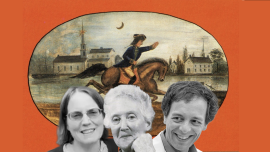What does Paul Revere’s Midnight Ride mean today, and who does it matter to? In this panel, a university professor, a high school teacher, and a public history content creator will discuss how the Midnight Ride resonates (or doesn’t) with their audiences. They will compare perspectives on societal trends that influence whether a historical event like this feels relevant today.
Moderated by Dr. Noelle Trent, Museum of African American History, Boston, with Dr. Eileen Ka-May Cheng, History Faculty, Sarah Lawrence College; Kerry Dunne, head of the History & Social Studies department at Lexington High School, and Ahsante Bean, creator of Bean Thinking, a YouTube channel exploring American politics through history.







